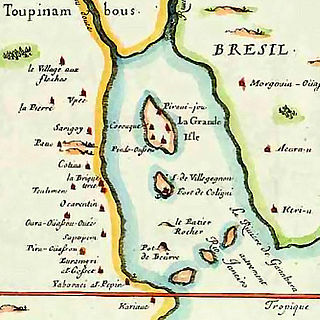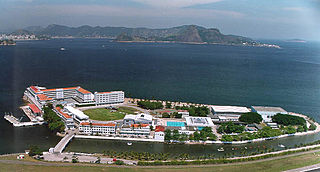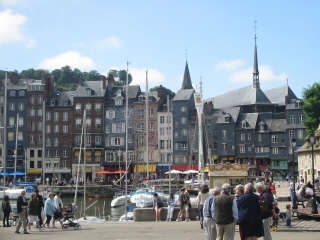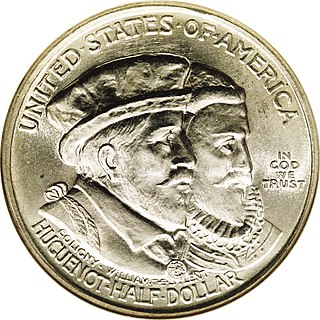Related Research Articles

France began colonizing the Americas in the 16th century and continued into the following centuries as it established a colonial empire in the Western Hemisphere. France established colonies in much of eastern North America, on several Caribbean islands, and in South America. Most colonies were developed to export products such as fish, rice, sugar, and furs.

The French Wars of Religion refers to the period of civil war between French Catholics and Protestants from 1562 to 1598. Between two and four million people died from violence, famine or disease directly caused by the conflict, and it severely damaged the power of the French monarchy. One of its most notorious episodes was the St. Bartholomew's Day massacre in 1572. The fighting ended with a compromise in 1598, when Henry of Navarre, who had converted to Catholicism in 1593, was proclaimed King Henry IV of France and issued the Edict of Nantes, which granted substantial rights and freedoms to the Huguenots. However, Catholics continued to disapprove of Protestants and of Henry, and his assassination in 1610 triggered a fresh round of Huguenot rebellions in the 1620s.

Gaspard de Coligny, seigneur de Châtillon, was a French nobleman, Admiral of France, and Huguenot leader during the French Wars of Religion. He served under kings Francis I and Henry II during the Italian Wars, attaining great prominence both due to his military skill and his relationship with his uncle, the king's favourite Anne de Montmorency. During the reign of Francis II he converted to Protestantism, becoming a leading noble advocate for the Reformation during the early reign of Charles IX.

Nicolas Durand, sieur de Villegaignon, also Villegagnon was a Commander of the Knights of Malta, and later a French naval officer who attempted to help the Huguenots in France escape persecution.
Mem de Sá was a Governor-General of the Portuguese colony of Brazil from 1557 to 1572. He was born in Coimbra, Kingdom of Portugal, around 1500, the year of discovery of Brazil by a naval fleet commanded by Pedro Álvares Cabral.

Jean Ribault was a French naval officer, navigator, and a colonizer of what would become the southeastern United States. He was a major figure in the French attempts to colonize Florida. A Huguenot and officer under Admiral Gaspard de Coligny, Ribault led an expedition to the New World in 1562 that founded the outpost of Charlesfort on Parris Island in present-day South Carolina. Two years later, he took over command of the French colony of Fort Caroline in what is now Jacksonville, Florida. He and many of his followers died at the hands of Spanish soldiers during the Massacre at Matanzas Inlet, near St. Augustine.

France Antarctique was a French colony in Rio de Janeiro, in modern-day Brazil, which existed between 1555 and 1567, and had control over the coast from Rio de Janeiro to Cabo Frio. The colony quickly became a haven for Huguenots, and was ultimately destroyed by the Portuguese in 1567.

Equinoctial France was the contemporary name given to the colonization efforts of France in the 17th century in South America, around the line of Equator, before "tropical" had fully gained its modern meaning: Equinoctial means in Latin "of equal nights", i.e., on the Equator, where the duration of days and nights is nearly the same year round. The settlement was made in what is now known as the Bay of São Luis and lasted for 3 years.

Fort Coligny was a fortress founded by Nicolas Durand de Villegaignon in Rio de Janeiro, Brazil in 1555, in what constituted the so-called France Antarctique historical episode.

Guanabara Bay is an oceanic bay located in Southeast Brazil in the state of Rio de Janeiro. On its western shore lie the cities of Rio de Janeiro and Duque de Caxias, and on its eastern shore the cities of Niterói and São Gonçalo. Four other municipalities surround the bay's shores. Guanabara Bay is the second largest bay in area in Brazil, at 412 square kilometres (159 sq mi), with a perimeter of 143 kilometres (89 mi).

Villegagnon Island is located near the mouth of the large Guanabara Bay, in the city of Rio de Janeiro, Brazil.

Jean de Léry (1536–1613) was an explorer, writer and Reformed pastor born in Lamargelle, Côte-d'Or, France. Scholars disagree about whether he was a member of the lesser nobility or merely a shoemaker. Either way, he was not a public figure prior to accompanying a small group of fellow Protestants to their new colony on an island in the Bay of Rio de Janeiro, Brazil from 1557 to 1558. There he produced the first known transcriptions of native American music: two chants of the Tupinambá, near Rio de Janeiro. The colony, France Antarctique was founded by the Chevalier de Villegaignon, with promises of religious freedom, but on arrival, the Chevalier contested the Protestants' beliefs and persecuted them. After eight months the Protestants left their colony and survived for a short time on the mainland, living amongst the Tupinamba Indians. These events were the basis of de Lery's book, History of a Voyage to the Land of Brazil, Also Called America (1578). Exhausted and starving, they then returned to France aboard a pirate ship.

Several years after the Portuguese first explored Brazil, French traders in search of pau-brasil reached the rich area extending from the Cape Frio coast to the beaches and islands of Guanabara Bay, the economic and, above all, strategic importance of which was already well-known.

France–Americas relations started in the 16th century, soon after the discovery of the New World by Christopher Columbus, and have developed over a period of several centuries.

Philippe de Corguilleray, Sieur du Pont, was a Burgundian nobleman who is known for leading a group of Calvinist men from Geneva to the French colony of France Antarctique in Brazil in 1556. The contingent he led included writer Jean de Léry.
Pierre Richier, also Pierre Richer, dit de Lisle, was a French Calvinist theologian, who accompanied Philippe de Corguilleray on a French expedition to Brazil in 1556, to reinforce the colony of France Antarctique. He was a member of a contingent of 14 Calvinist people dispatched from Geneva. He later became the main actor in developing La Rochelle as a Huguenot capital.

French Florida was a colonial territory established by French Huguenot colonists as part of New France in what is now Florida and South Carolina between 1562 and 1565.

Events from the year 1555 in France.
Guillaume Chartier was a Calvinist theologian and Protestant pastor from Geneva, active between 1555 and 1560.

The Huguenot-Walloon half dollar or Huguenot-Walloon Tercentenary half dollar is a commemorative coin issued by the United States Bureau of the Mint in 1924. It marks the 300th anniversary of the voyage of the Nieuw Nederlandt which landed in the New York area in 1624. Many of the passengers were Huguenots from France or Walloons from what is now Belgium; they became early settlers of New York State and the surrounding area.